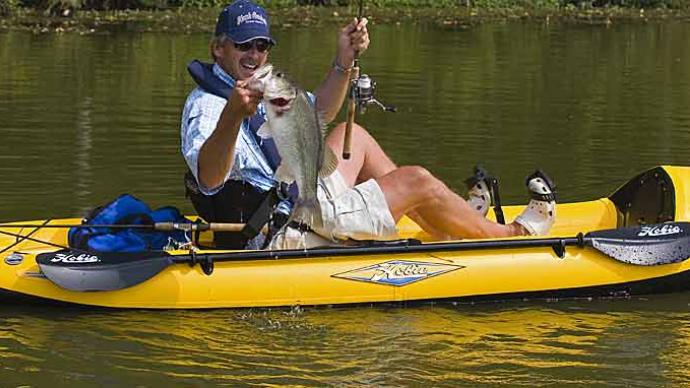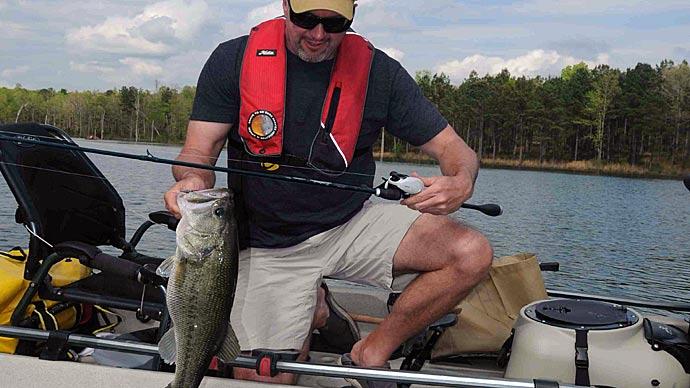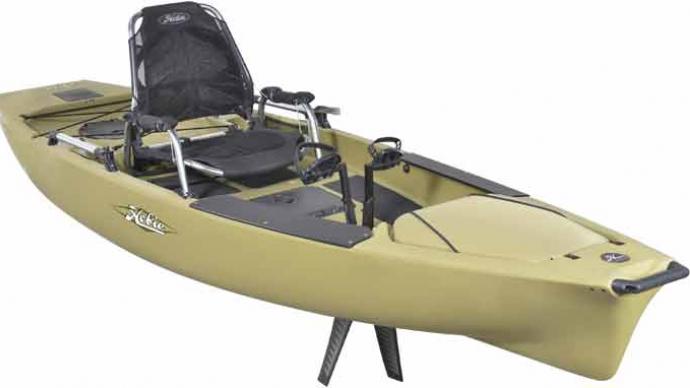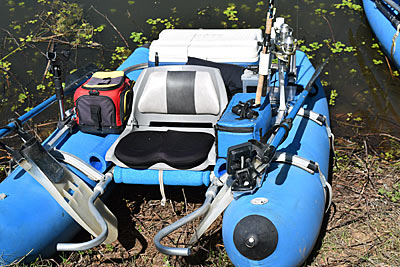
The anglers who fish from kick boats, kayaks, and float tubes swear by their fish-catching power. Easier to maneuver and lighter on the wallet than full-sized boats, they are perfect for shallow lakes without launch ramps and rivers with rough patches. And they aren’t afraid of big water.
To gain those advantages, human-powered watercraft go without some of the luxuries found on bass boats. There aren’t expansive casting decks or cavernous storage. And they can’t travel long distances quickly.
But fishing from one doesn’t have to be a spartan experience. With a little effort, money, and wire, you can add various electrically powered accessories, including a fish finder, livewell, and trolling motor. All you need is a little know-how.
Battery
Jeff Wilson is president of Bass-n-Tubes, a northern California bass club with about 40 members. It’s affiliated with The Bass Federation and organizes open and club tournaments for anglers who fish from kick boats, kayaks, and float tubes. All of them use electrically powered accessories.
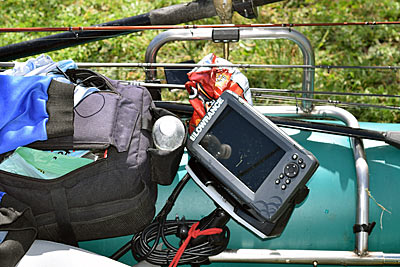
At the heart of each system is a 12-volt, 12-amp hour battery. “We generally use an alarm size battery,” Wilson said. They are about 4 inches wide, 4 inches tall, and 6 inches long. He said that’s comparable to two of the old-style lantern batteries. They weigh less than 10 pounds, an essential consideration on smaller watercraft. Traditional deep-cycle batteries easily weigh more than 50 pounds.
Wilson stores his battery — which lasts two trips on one full charge — inside a resealable container secured behind his kick boat’s seat. It’s wired to a box of switches, each controlling a fuse-protected accessory. He said that the complete setup looks like a wiring harness from a bass boat.
Many anglers use 14- to 18-gauge wire, leaning toward a heavier gauge as the run gets longer and more accessories are connected. The best bet for selecting the correct size wire for your application is following the accessories manufacturer’s recommendations.
Fish finder
Wilson secures each set of wires to his kick boat’s frame, and the first pair goes straight to his fish finder. “We use the same fish finders you would use on a bass boat,” he said. While most of the anglers he fishes use units with 7-inch screens, one has stepped up to a 10-inch model. “We tease him because he could watch movies on it,” he said.
The trend toward using multiple units — which allows certain functions, such as mapping, to be displayed larger than on a split-screen — hasn’t reached the kick boat world, mainly because they’re not needed. Instead of standing several feet from a unit, like anglers on a bass boat, units are mounted front, center, and inches from the user. Wilson said that makes it easy to see everything, even when a 5-inch screen is split several ways.
Wilson said most kick boat anglers mount the transducer behind them, where it’s out of the way. It’s attached to a hinged bracket that the angler raises or lowers with strings. That comes in handy when fishing shallow water or clearing collected aquatic vegetation, which disrupts the sonar signal.
Wilson prefers his transducer closer. “I like mine by my feet, so I am over where I’m fishing,” he said. It resembles mounting a bow unit’s transducer on the trolling motor. There it provides more accurate information when fishing vertically in deep water, which is something kick boat anglers do, too. In a February 2018 club tournament on Lake Camanche, he said the winner caught his bass in 40 feet of water.
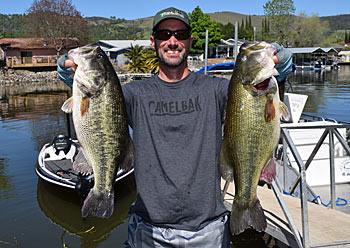
The mounts can handle the larger side- and down-imaging transducers. While those functions are used for the same reason as on bass boats — searching for bass, cover, and structure — Wilson said kick boaters come from a different direction because of their lack of long-distance mobility. Instead of eliminating water, he said they are used to pick apart a spot, helping maximize the number of bass caught.
Anglers who sit in a kayak or float tube use fish finders too. The rigging and equipment are the same as what’s used in a kick boat, though different allowances are made for mounting the unit and transducer. On float tubes, for example, both can be on one bracket that straps around the tube. Many kayaks are designed to accept a fish finder and its transducer. FeelFree Kayaks, for example, have a “pod” that handles both, eliminating the need to punch mounting holes anywhere else in the kayak.
Livewell
On tournament days, Wilson plugs in one more accessory on his kick boat, carrying several rods and enough tackle to cover any fishing situation. It’s a 48-quart cooler that’s used as a livewell. It’s not a requirement in the club’s events. Those few who would propel their kick boats with flippers instead of oars, or use a float tube, can use a follow-me bag — a floating PVC frame covered with mesh — to hold their catch.
Unlike many tournaments that use human-powered watercraft, Bass-n-Tubes’ tournaments require contestants to bring their catch — alive and kicking — to a central weigh-in rather than register them through a rigid system of photographs that display an individual identification. Wilson said it allows them to share their catch with family, friends, and competitors.
Two items are needed to make the cooler function as a livewell, and Wilson wires both to the switch box. The first is a 500-gallon-per-hour bilge pump, which fills the cooler with fresh water. The other is an aerator, which ensures the water is well oxygenated.
That level of care doesn’t end once bass are removed from the livewell. Wilson said a live-release boat was used at a recent club tournament on Clear Lake, the famous California fishery known for giant swimbaits and equally large bass. Like those at more significant boat events, it was a converted pontoon boat sporting large livewells, where bass are placed after being weighed. Once the boat reaches open water, the bottoms open, and the bass are released.
Trolling motor
The battery tucked behind the seat isn’t big enough to power every possible component on a kick boat. On tournament practice days or while fun fishing, some anglers attach a trolling motor, which makes covering more water easier.
Some manufacturers, including Colorado and Outcast, offer a trolling-motor mount for their kick boats. Wilson said most anglers who use one choose a 30-pound thrust model. And instead of the livewell, they carry a deep-cycle battery in addition to the smaller battery. Trolling motor leads bypass the switch box and go straight to the deep-cycle battery.
But Wilson doesn’t count himself among them. “I feel [a trolling motor] kind of hampers me,” he said. The increased mobility makes it easy to find bass out of range on tournament day when propulsion returns to human power.
Navigation light and accessories
Wilson said competitors must display a white light on their craft from takeoff through at least 15 minutes after safe light at every club-sponsored tournament. It’s a safety requirement that ensures faster moving and bigger boats see them.
While there are battery-powered add-on options, Wilson just runs one more set of wires from his switch box to short strips of LED lights. “I have mine on the two front rails,” he said.
Wilson has one more set of wires that he’s about to run. He’s working on adding a USB connection at the switch box. That will give him a way to charge his phone. “I’m still working on it, but I’m confident it will work,” he said.


